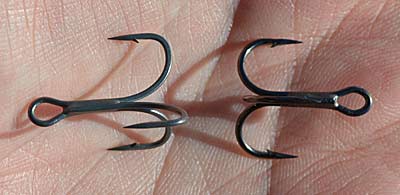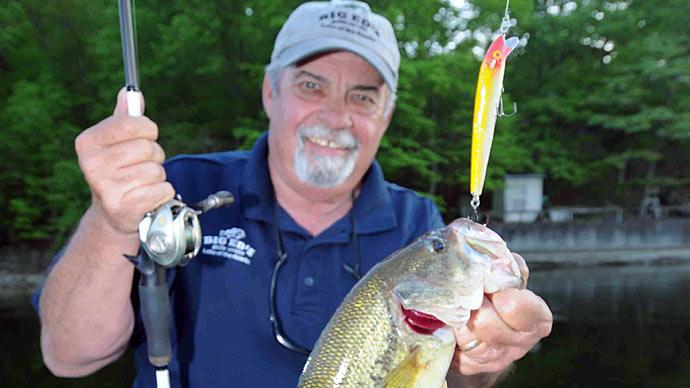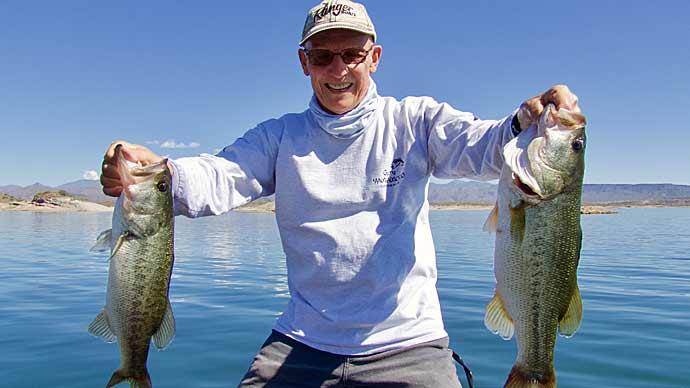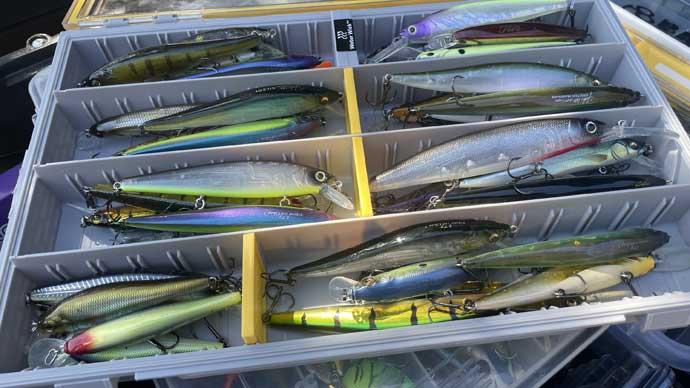
March weather is a toss-up most years. It might come in like a lion and leave like a lamb, but the opposite is just as likely. Depending on where you call home, it could be a month of fine fishing conditions or checking your local waters to see if they’re still locked under ice. Changes come week by week, day by day, and even hour by hour.
Bassmaster Elite Series angler Jay Przekurat sees March’s variations firsthand while traveling the tournament trail. The Stevens Point, Wisconsin, angler started in March 2024 in Texas, competing on Lake Fork, the legendary big-bass factory. The air was warm, and the bass were biting. The scenario was different back home, where anglers were still looking forward to open water, and the weather he was enjoying was still weeks away.
Typical March conditions lie between winter and Chamber of Commerce weather for most bass anglers. But there are common characteristics, including:
- Warming water: More daylight and warmer nights team up to increase water temperature. It may start the month in the 40s, but by the time April is nearing, it should be pushing 60.
- Passing fronts: Weather systems come and go during March, each temporarily slowing the bass bite. Severity and frequency mellow as the month progresses.
- Changing water color: Runoff from spring rains stains water, especially the shallow spawning stretches that are the destination of prespawn bass.
- Varying locations: Prespawn bass are on the move, swimming to spawning spots from winter haunts. They hunker down on structure and cover in a variety of depths along the way, starting and stopping as conditions dictate.
But bass can't read calendars. And with the unpredictability of weather and the latitude of your favorite fishing holes, these conditions may or may not represent March. For example, you might see them in April if you live further north in the bass range. And they may be old news by March if you live in the southern-most reaches. But most will experience at least some of them during the month.
Despite that variability, Przekurat believes there is at least one piece of consistency in March bass fishing, and that’s a jerkbait. It’s what he fishes most this month, wherever he launches his boat. "It's a fish-catching bait," he said.
Exploit Its Power
Jerkbaits have long been favorites of anglers chasing springtime bass, and that continues today. Improvements, from realistic color patterns to shifting weights extending casts, have expanded their versatility. “There are endless possibilities with a jerkbait,” Przekurat said. “It stays in the strike zone and tracks well. You can incorporate action.”

Slender in profile and sporting two or three treble hooks and a diving bill, a jerkbait’s dipping and diving action mimics an injured baitfish, which are easy targets for hungry prespawn bass. They’re at home in most fishing situations found in 15 feet or less of water. Windblown main-lake points, beds of submerged aquatic vegetation, rock-covered flats and secondary points, and mouths of shallow pockets are all prime targets under March-like conditions.
The key to getting the most bites on a jerkbait, regardless of where you cast it, is finding the best combination of twitches and pauses. That retrieve cadence changes with conditions. In cold water, for example, bass often want longer pauses and slower twitches. In warm water, pauses can be eliminated altogether. Przekurat lets the bass tell him what they want, experimenting with different combinations until the strikes start.
A productive cadence only lasts as long as the current conditions. So, continually experiment as the water temperature warms; for example, cold fronts pass, and bass move between pieces of cover and structure. Enjoy one while it’s working, but keep your eyes peeled for changes and adjust your offering in response.
As with many favorite lures and patterns, forward-facing sonar changes how jerkbaits are fished. Przekurat used the technology to find submerged stumps that produced key bass on his way to a 16th-place finish at the 2024 Elite Series tournament on Lake Fork. It helped him fine-tune his presentation, too. Once he found a sweet spot, he watched the bass react to his jerkbait, letting him try different cadences, colors, and actions until he found the combination that unlocked a strike. “And that’s where FFS comes in,” said the 2022 Elite Series Rookie of the Year. “It’s almost like [spawning] bed fishing.”
Make Improvements
Creating the best cadence for the current conditions puts you well on your way to catching more and bigger bass with a jerkbait. But there’s more you can do to improve your offering. And that has everything to do with what your jerkbait does on the pause — float, suspend, or sink. That bit of movement pushes a following bass to strike.
Przekurat witnessed the power of the pause firsthand at the recent Lake Fork tournament. “I didn’t want it to suspend or sink [on the pause],” he said. “I wanted it to slowly float. I’d let it sit, and that would get their attention.”
While a jerkbait suspended motionless works in the coldest water, a slowly rising bait will trigger springtime bass. Przekurat believes that for a couple of reasons. “That’s where they want to eat,” he said. “In spring, they sit up and like to know what’s going on. They look up. And [a sinking jerkbait] is very unnatural. Dying baitfish usually float, not sink.”
Getting a jerkbait to suspend or rise can be done in several ways. First, you can buy ones designed to do one or the other. But those are only reliable under controlled conditions. Wind, current, and even water temperature can affect them. Here are three others:
- Lead tape: These dots or strips have an adhesive back that attaches them to your lure. They work best along the lure’s belly, either side of the front hook.
- Lead wire: Mostly used in fly tying, it can be wrapped around the shank of one or more of your jerkbait’s treble hooks. It’s easy to add or remove as conditions and needs change.
- Drill and fill: Create a hole just large enough to add a BB or two to a hollow jerkbait or a split shot to a solid one. Then, seal the hole with epoxy, making the adjustment permanent.
These options take skill and a bit of luck — plenty of each for the third — to find the amount of weight that achieves the desired action without killing the action. So, Przekurat relies on an easier fourth means, swapping hooks. And while many anglers push changing hook sizes — larger for more weight, smaller for less — he doesn’t. Larger hooks, for example, are likelier to tangle, killing a cast by negatively affecting the jerkbait’s action. Instead, he keeps the same size but changes their composition, shaving weight with light-wire hooks and adding it with heavy-wire ones.
Przekurat practiced what he preached at Lake Fork. One of his jerkbaits was sinking. On closer inspection, he noticed it was equipped with heavy-wire hooks. So, he swapped them for light-wire ones, which began slowly rising when he paused.
Depending on the make and model of your jerkbait, you may have to switch one or all of the trebles. So, keep going if your first adjustment doesn't bring the desired change. Keep going until the bass tell you that it's correct.
Choose Your Weapon
Przekurat fishes Strike King KVD jerkbaits, which are offered in two sizes—200 and 300—and shallow- and deep-diving versions. He ties on the two-hook 200 one when fishing water 5 feet deep or shallower. The 300 size, which has three treble hooks, is offered in shallow- and deep-diving versions. He ties on a deep-diver most of the time. “I’ve got that bait down to 12 feet on a long cast,” he said.

That extra depth is essential when Przekurat is chasing smallmouth, which he believes are more bottom-oriented in spring than largemouth. "A smallmouth isn't going from 10 feet deep to 2 feet to eat, especially when the water is super clear," he said.
Przekurat chooses his jerkbait’s color based on forage and water clarity. But he adds a caveat in spring. “Even if the water is clear, I gravitate toward anything with some chartreuse in it,” he said. Bass like that brighter color. It may be because they’re amped up for spawning, or maybe their increasing metabolism in the warming water makes them aggressive. And it might be easier for them to see in water stained by runoff.
Przekurat’s favorite patterns include baitfish and pro blue. “That’s one of the greatest jerkbait colors of all time,” he said of the latter. And if he’s faced with extremely stained water, he reaches for a pearl-colored one. “It really stands out,” he said.
Rig Up
Choosing and customizing your jerkbait are the first steps to getting bass-approved action. Next, you need the right gear to accentuate it.
Przekurat grabs a Lew's Custom Lite casting rod that measures 6 feet and 8 inches long. That relatively short length makes the downward movements used to activate a jerkbait more comfortable. He matches it with a Team Lew's Custom Pro casting reel outfitted with a 7.5:1 gear ratio. It brings speed, ensuring solid hooksets by quickly removing any slack created from working your jerkbait.
Przekurat spools his reel with Seaguar Tatsu 12-pound test fluorocarbon line. Its diameter is thinner than other 12-pound test lines. That means less water resistance, allowing his jerkbait to reach greater depths. But it doesn’t sacrifice strength. “I feel like I’m using 10-pound test, but it’s still strong,” he said.
BassResource may receive a portion of revenues if you make a purchase using a link above.




